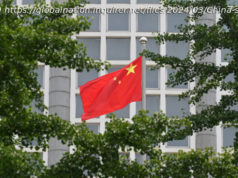Central banks are leery of the newly arrived Chinese yuan.
AP/Jacquelyn
Martin
Central banks are leery of the newly arrived Chinese yuan.
Over the decades, there have been a number of efforts to deflate
the dollar’s hegemony as a global reserve currency, which it has
maintained since World War II. Some of these efforts – such as
the creation of the euro – have made a visible dent into the
dollar’s status. Other efforts have essentially passed unnoticed.
Now there’s a new contender: the Chinese yuan.
On December 31, the IMF released its report on the Currency
Composition of Official Foreign Exchange Reserves (COFER) for Q3
2017. So how has the US dollar fared as the top world reserve
currency, now that the Chinese yuan has also been anointed as
one, and that the euro has emerged from its debt crisis?
First things, first. The IMF doesn’t really disclose all that
much. The COFER data for the individual countries – the level of
their reserve currencies and how they allocate them – is
“strictly confidential,” it says. So what we get to look at is
the global allocation by currency.
Total global foreign exchange reserves rose to $11.3 trillion in
Q3 2017, within the range of the past three years, between $10.7
trillion (Q4 2016) and $11.8 trillion (Q3,2014). But
something is happening to “allocated reserves.”
Not all central banks disclose to the IMF how their foreign
exchange reserves are allocated. In Q3 2017,14.6% of the
reserves hadn’t been allocated. But this number is plunging. In
Q3 2014, just three years ago, it was still 41.2%. This means
that more and more central banks report to the IMF their
allocation of foreign exchange reserves, and the COFER is getting
broader.
So of the 85.4% of the officially “allocated” reserve currencies
in Q3 2017:
Wolf
Street
The Chinese yuan made its entry after IMF boss Christine Lagarde
and the IMF staff declared in mid-November 2015 that they were
gung-ho about adding it to the IMF’s currency basket, the Special
Drawing Rights (SDR), which is an important step toward becoming
a major global reserve currency. At the end of November 2015, it
was approved by the board. And it took effect in October 2016.
Sure enough, in Q4 2016, the Chinese yuan started showing up in
the COFER data as a global reserve currency with a share of
1.08%. But rather than soaring, it didn’t move at all over the
first two quarters in 2017. And in Q3, it ticked up to a still
minuscule 1.1%. Central banks do not appear to be overeager to
hold this currency in large amounts.
The chart below shows the changes since Q3 2014. The black line
at the top is the US dollar – its hegemony unbroken. The euro
(blue line) has remained fairly stable around 20%. The dollar and
euro combined account for 83.5% of the allocated foreign exchange
reserves. That doesn’t leave much room for other
currencies. As a memo entry (not part of the percentages):
The descending purple line denotes the shrinking unallocated
reserves.
Note the Chinese yuan, the bright red line scraping along the
very bottom since Q4 2016, just above the Swiss franc:
Wolf Street
And the dollar’s hegemony over the past decades? The chart
below shows the dollar’s share of allocated global official
reserves going back to 1965. The low point in that time frame was
in 1991 with a share of 46%. The euro made a visible dent
starting in 2001. On the other hand, the Financial Crisis had no
impact:
Wolf Street
While the euro has become a major force, it has replaced the
Deutsche mark and other European currencies, and so the net
impact on the dollar’s hegemony wasn’t huge. The Chinese yuan,
which some folks thought would pull the rug out from under the
dollar, is barely visible in the mix. And folks eagerly waiting
for the “death of the dollar,” the “end of the dollar hegemony,”
and similar mayhem will need to be patient.
During prior incidents of an “inverted” yield curve, the Fed had
no tools to get the market to push up long-term yields. Today it
has one: the QE Unwind. Read… The Dreaded “Flattening Yield Curve” Meets QE
Unwind






